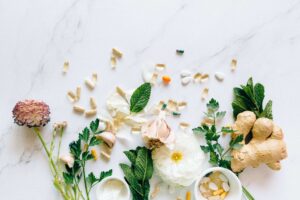The Renaissance of Clean Beauty and Time-Honored Ingredients

In the realm of beauty, the clean beauty movement is not confined to borders; it’s a global phenomenon reshaping the industry. As consumers increasingly prioritize sustainability, transparency, and the use of natural ingredients, traditional beauty practices from around the world are making a remarkable comeback. In this blog, we’ll explore the global reach of clean beauty, highlighting traditional ingredients that are reclaiming their spotlight in skincare and cosmetics, and the cultural resurgence that accompanies this paradigm shift.
The Global Influence of Clean Beauty
Clean beauty transcends geographical boundaries, connecting beauty enthusiasts worldwide under a shared commitment to natural, sustainable, and ethical practices. This movement has ignited a renewed interest in traditional beauty ingredients that have been treasured by various cultures for centuries.
One of the captivating aspects of clean beauty on a global scale is the resurgence of cultural beauty rituals. From Ayurvedic practices in India to ancient Chinese remedies, traditional ingredients are taking center stage, breathing new life into time-tested beauty secrets.
Rediscovered Treasures
1. Turmeric (India):
Cultural Significance: Revered in Ayurveda for its anti-inflammatory and antioxidant properties, turmeric has been a staple in Indian skincare for centuries. It’s used for brightening the skin, combating acne, and promoting a healthy glow.
Clean Beauty Integration: Turmeric’s popularity has surged in clean beauty formulations, with brands incorporating it into masks, serums, and cleansers to harness its healing benefits.
2. Ginseng (Korea):
Cultural Significance: A cornerstone of traditional Korean medicine, ginseng is celebrated for its rejuvenating and energizing properties. In skincare, it’s known for promoting collagen production, enhancing skin elasticity, and providing anti-aging benefits.
Clean Beauty Integration: Ginseng has found a prominent place in clean beauty formulations, particularly in Korean skincare brands that prioritize natural and cruelty-free ingredients. It’s a key player in serums and moisturizers.
3. Argan Oil (Morocco):
Cultural Significance: Native to Morocco, argan oil has been a beauty elixir for Moroccan women for centuries. Rich in vitamins and antioxidants, it’s cherished for its moisturizing and anti-aging properties.
Clean Beauty Integration: Argan oil has become a sought-after ingredient in clean beauty due to its versatility. It’s commonly found in clean skincare products, hair treatments, and even natural makeup formulations.
4. Camellia Oil (Japan):
Cultural Significance: Camellia oil, extracted from the seeds of the Camellia japonica flower, has been a beauty staple in Japan for centuries. Geishas traditionally used it to nourish and protect their skin and hair. Clean Beauty Integration: With its lightweight and fast-absorbing nature, camellia oil is now embraced in clean beauty formulations worldwide. It’s often found in facial oils, cleansers, and hair care products.
5. Aloe Vera (Mexico):
Cultural Significance: Aloe vera, native to Mexico, has been utilized for its soothing and healing properties by various cultures, including the ancient Aztecs. It’s renowned for its ability to hydrate and calm irritated skin.
Clean Beauty Integration: Aloe vera’s popularity in clean beauty is widespread. It’s a prevalent ingredient in natural skincare, including cleansers, moisturizers, and soothing masks.
Clean Beauty Brands Embracing Global Traditions
1. Forest Essentials (India):
This Indian brand draws inspiration from Ayurvedic principles, incorporating traditional ingredients like saffron, turmeric, and rose water into its clean beauty products. Their formulations prioritize purity and authenticity, contributing to a holistic skincare experience.
2. Innisfree (Korea):
Innisfree, a Korean beauty brand committed to clean and sustainable practices, integrates traditional Korean ingredients like green tea, volcanic ash, and ginseng into its products. The brand’s eco-friendly approach aligns with the principles of clean beauty.
3. Kahina Giving Beauty (Morocco):
Kahina Giving Beauty, inspired by the beauty rituals of Morocco, places a strong emphasis on clean, ethically sourced ingredients. Their hero ingredient, argan oil, takes center stage in their skincare line, reflecting a commitment to both efficacy and sustainability.
4. Tatcha (Japan):
Tatcha, a luxury Japanese-inspired skincare brand, incorporates traditional Japanese ingredients like camellia oil, green tea, and rice bran into its clean formulations. The brand’s philosophy emphasizes the timeless beauty secrets of the geisha tradition.
5. Biossance (Mexico):
Biossance, a clean beauty brand, harnesses the power of plant-based squalane derived from sugarcane. While not traditional in the sense of ancient rituals, the brand’s sustainable approach aligns with the growing global interest in clean beauty.

Clean Beauty as a Catalyst for Cultural Appreciation
Clean beauty’s embrace of traditional ingredients from around the world serves as a powerful tool for breaking stereotypes and fostering cultural appreciation. The incorporation of diverse beauty practices into mainstream skincare promotes a more inclusive and accepting beauty landscape.
As clean beauty brands source traditional ingredients from various cultures, ethical considerations and fair trade practices become integral. This approach ensures that communities contributing to the cultivation of these ingredients are treated ethically and sustainably, aligning with the core values of clean beauty.
The Future of Clean Beauty: A Global Tapestry
The fusion of clean beauty with traditional ingredients marks a cultural renaissance in the beauty industry. As consumers seek authentic and meaningful experiences, brands that honor global beauty traditions will continue to flourish. This cultural exchange not only enriches the beauty landscape but also promotes unity and understanding.
The global adoption of traditional ingredients in clean beauty formulations has a positive impact on local communities. By supporting fair trade practices and sustainable sourcing, clean beauty contributes to the economic empowerment of those who have preserved these beauty traditions for generations.
Clean beauty’s integration of traditional ingredients sets a new standard for beauty that extends beyond aesthetic ideals. It reinforces the idea that beauty is diverse, timeless, and deeply rooted in cultural heritage. As this approach gains momentum, it has the potential to reshape societal perceptions of beauty on a global scale.
Clean beauty’s embrace of traditional ingredients from around the world not only transforms skincare and cosmetic formulations but also fosters a global appreciation for diverse beauty traditions. As clean beauty continues to break down borders, the beauty industry becomes a canvas for cultural exchange, celebrating the rich tapestry of traditional ingredients that have stood the test of time. The global resurgence of these treasures not only elevates clean beauty but also paves the way for a more inclusive and culturally enriched future in the world of beauty.




